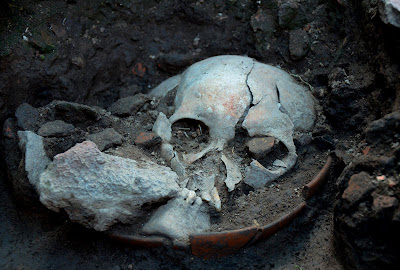Scientific Minds Want To Know
Archaeologists of the National
Institute of Anthropology and History (INAH) recently found the cranium
of a decapitated individual, dating back 500 years ago in the
Archaeological Zone in Tlatelolco, which is part of a small offering
located at the foot of the Great Temple of the site. |
| INAH's specialists found the cranium of a decapitated individual thought to be 500 years old [Credit: Meliton Tapia/INAH] |
The INAH specialist said that the finding was registered during the first phase of archaeological exploration, which is why it has been impossible to determine the dimensions of the offering, which could be of consecration, meaning it was placed here during the preparation rituals of the space that this edification would occupy.
“We’re delimiting the space to see if the oblation is composed exclusively of the cranium and the pot, or if we have more remains associated with it”, said Guilliem when he added that more physical anthropology studies should be made. Through the teething they have been able to determine he is an adult, most likely a war captive that would have been decapitated.
 |
| The
small offering was found at the foot of the Great Temple on the
pre-Columbian site after a custodian reported “what appeared to be a buried vessel” [Credit: Meliton Tapia/INAH] |
The discovery was made after a custodian, in charge of cleaning labors, as part of the Program of the Conservation of Archaeological Monuments 2013, reported what seemed to be a buried pot.
Upon inspection, rescue and excavation labors, the archaeologists Salvador Guilliem and Paola Silva found a small offering that had been covered with limestone, but because of the rain in the capital a small landslide occurred with facilitated its finding.
 |
| The
skull, found on top of the vessel, was from a young adult male, "very probably a prisoner of war” [Credit: Meliton Tapia/INAH] |
“We can’t lower excavation levels very quickly because there are fragments of ceramic that we found near the offering, and we don’t know if they belong to it or if they belong to some other filling; before we remove them we have to check their disposition and how they got there, all the while making a thorough registry of the context”.

No comments:
Post a Comment